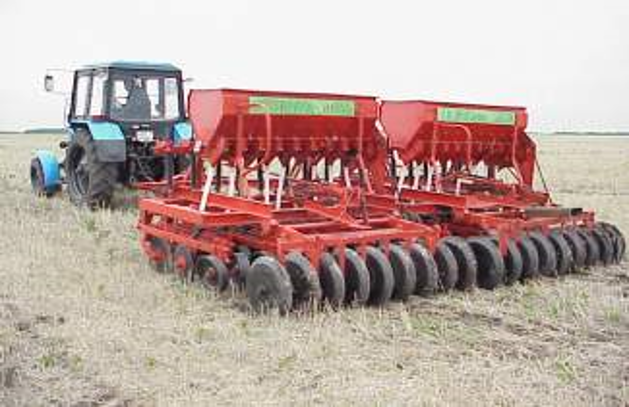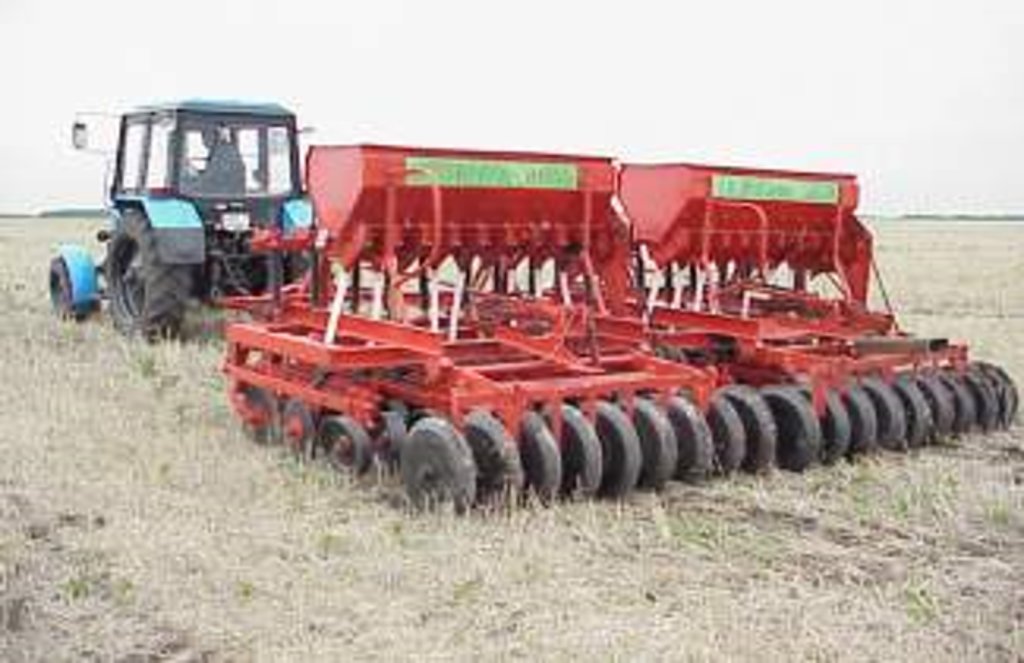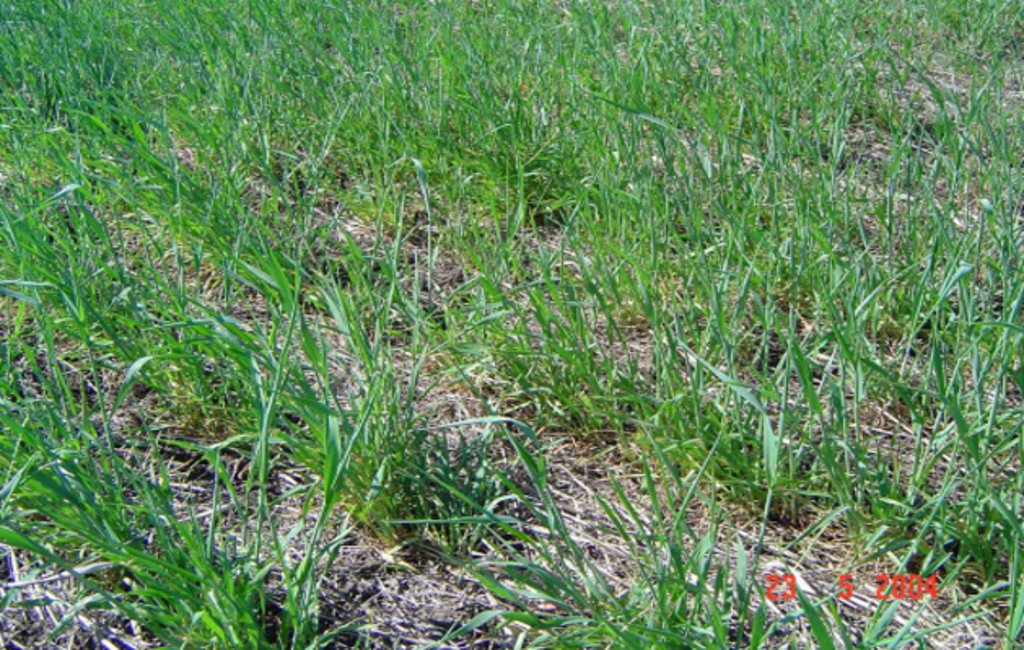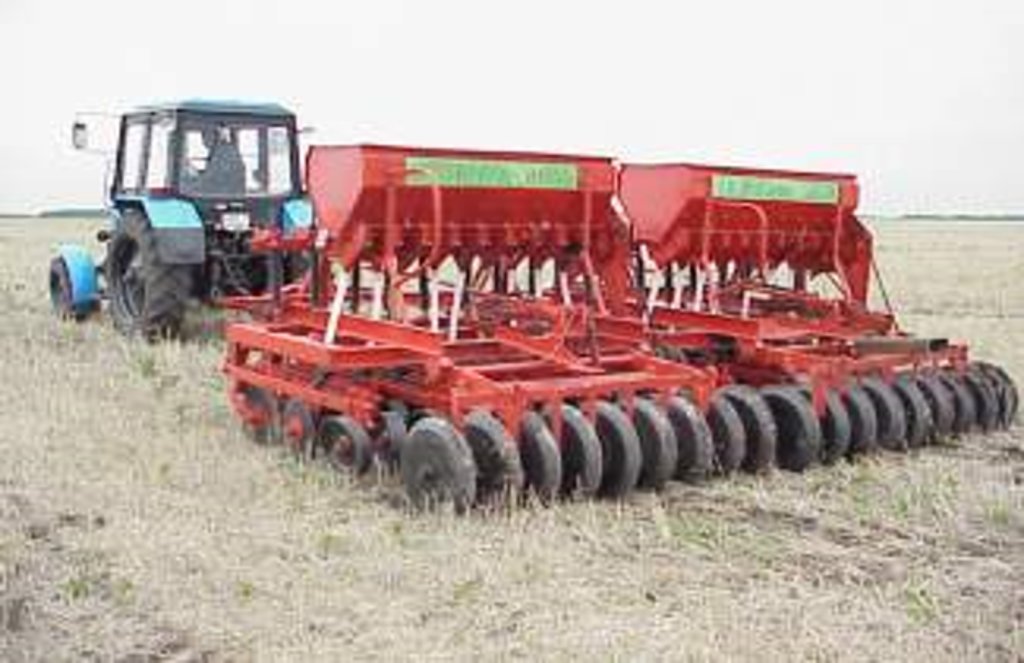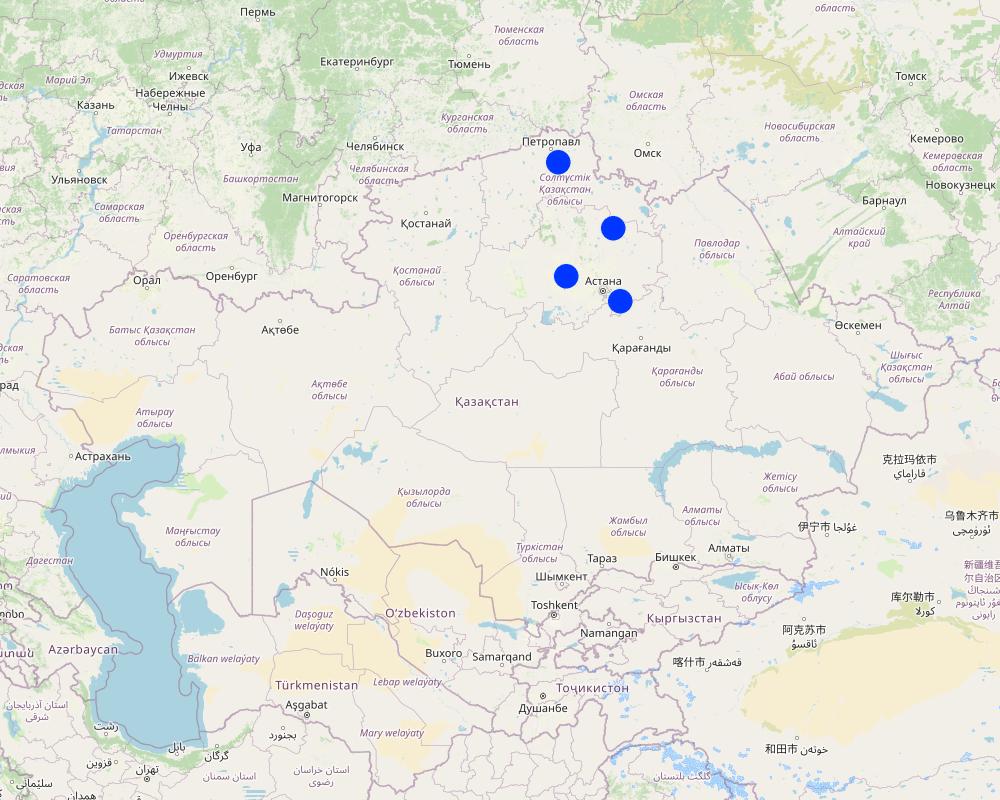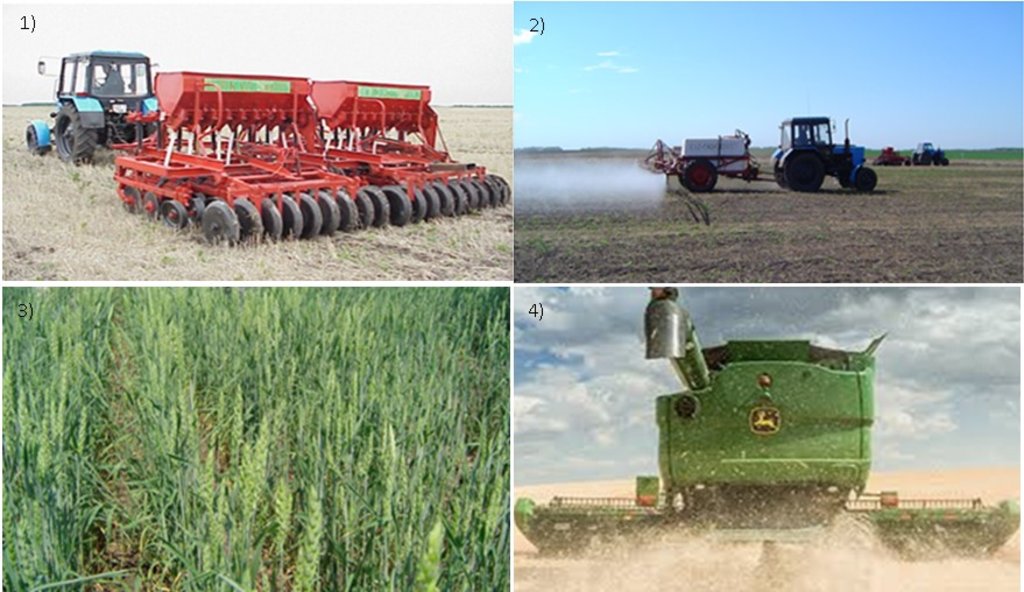Conservation Agriculture for cereal production in rainfed areas of Kazakhstan [Kazajstán]
- Creación:
- Actualización:
- Compilador: Kulyash Iskandarova
- Editor: Hayot Ibrakhimov
- Revisor: Rima Mekdaschi Studer
Conservation Agriculture for cereals production in rainfed agriculture lands
technologies_5673 - Kazajstán
Visualizar secciones
Expandir todo Colapsar todos1. Información general
1.2 Detalles de contacto de las personas de referencia e instituciones involucradas en la evaluación y la documentación de la Tecnología
Persona(s) de referencia clave
Expert/Consultant:
Karabayev Muratbek
CIMMYT-Kazakhstan
Kazajstán
Nombre del proyecto que financió la documentación/ evaluación de la Tecnología (si fuera relevante)
Integrated natural resources management in drought-prone and salt-affected agricultural production landscapes in Central Asia and Turkey ((CACILM-2))Nombre de la(s) institución(es) que facilitaron la documentación/ evaluación de la Tecnología (si fuera relevante)
Kazakh Research Institute for Livestock and Fodder Production (Kazakh Research Institute for Livestock and Fodder Production) - Kazajstán1.3 Condiciones referidas al uso de datos documentados mediante WOCAT
El compilador y la/s persona(s) de referencia claves aceptan las condiciones acerca del uso de los datos documentados mediante WOCAT:
Sí
1.4 Declaración de la sostenibilidad de la Tecnología descrita
¿La Tecnología aquí descrita resulta problemática en relación a la degradación de la tierra, de tal forma que no puede considerársela una tecnología sostenible para el manejo de la tierra?
No
Comentarios:
The technology helps to restore degraded land
1.5 Referencia al (los) Cuestionario(s) de Enfoques MST (documentados usando WOCAT)
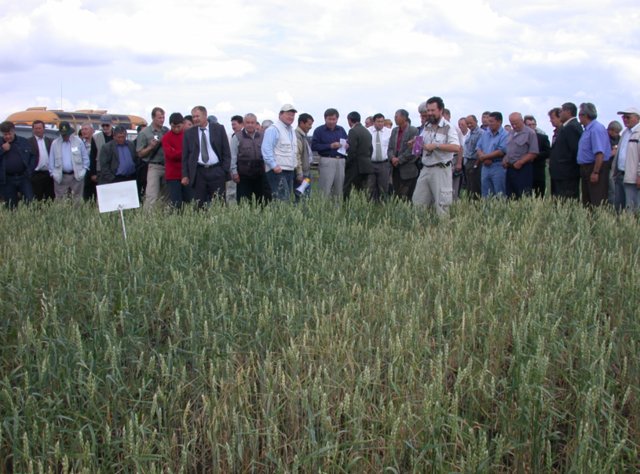
Awareness Raising for SLM Using Conservation Agriculture [Kazajstán]
Raising awareness and strengthening the capability and skills of farmers, agriculture specialists and researchers in developing and adoption resource-saving, profitable and environmentally friendly cereal production through Conservation Agriculture practices.
- Compilador: Kulyash Iskandarova
2. Descripción de la Tecnología MST
2.1 Breve descripción de la Tecnología
Definición de la Tecnología:
Conservation agriculture applied in Northern Kazakhstan is based on no-tillage direct sowing of cereals into the soil permanently covered by crop residues. It contributes to reverse soil degradation, enhance water use efficiency, increase crop productivity in the rainfed lands.
2.2 Descripción detallada de la Tecnología
Descripción:
The cropping system in Northern Kazakhstan is based mainly on continuous wheat production using conventional technologies. Negative components of this system are intensive tillage, returning little organic matter to the land and monoculture. This system has led to soil degradation (wind and water erosion), soil fertility loss, boost-up of diseases, weed infestation and other problems.
Conservation Agriculture (CA) involves removing these negative components of conventional farming systems and includes three basic principles: 1) minimal soil disturbance, 2) permanent soil cover with crop residues and 3) crop rotation.
In accordance with these principles,
Conservation Agriculture technology includes 3 main operations:
1. Sowing with simultaneously soil fertilization using direct seeder.
2. Post-sowing (after 1-2 days) treatment by non-selective herbicide
3. Harvesting combined with simultaneous plant residues chopping and spreading
For comparison Conventional technology includes 7 operations:
1. Deep fall soil tillage (25 cm).
2. Early spring soil treatment.
4. Pre-sowing soil treatment.
5. Sowing with simultaneously soil fertilization using conventional seeder.
6. Selective herbicide application 2,4-Dichlorophenoxyacetic acid (2-4-D).
7. Harvesting.
The CA technology was applied in four farms in Akmola and North-Kazakhstan oblasts:
1.Farm “DARYN”, village Valikhanovo, Zharkainsky rayon, Akmola oblast, Kazakhstan.
2.Farm “Surayev”, village Vishnevka, Arshalinsky rayon, Akmola oblast, Kazakhstan.
3.Farm “Dostyk”, village Astrahanovka, Arshalinsky rayon, Akmola oblast, Kazakhstan.
4. Farm “Cherezdanov”, village Smirnovo, Akkayinskii rayon, Northern Kazakhstan oblast, Kazakhstan.
Depending on the capability of these four farms in total 330 ha agricultural land were allocated for the testing and adaptation of the technology. On each farm, field trials under equal conditions (soil, temperature, humidity, landscape, etc.) were conducted and included 2 treatments: Conventional (7 operations) and Conservation Agriculture (3 operations).
Analysis of 2002-2004 trials data demonstrated that yield of wheat and other cereals under CA technology was in average 15-25% higher in comparison with the conventional technology. The advantages of CA technology are especially evident in the years of drought (up to 40% in dry 2004 year). Economic evaluation of the technology made by two independent experts from Kazakhstan (Kazakh Research Institute for Grain Farming) and USA (Idaho State University) suggested that costs of labor, fuel, repairs and spare parts as well as machinery and equipment wearing-out under the Conservation Agriculture technologies is significantly lower as compared to those of traditional technology. In general, it is important to emphasize that the experience of the CA adaptation in North Kazakhstan helped farmers/land-users:
•To determine the appropriate level of tillage in a cropping system that is feasible with direct sowing and CA technology requirements as a potential goal.
•To retain sufficient residue on the soil surface to reduce soil erosion, enhance crop/water productivity, improve soil fertility (because of plant organic material bioprocessing in the soil) and better ensure long term, sustainable production.
•Employ economically viable, diversified crop rotations that can improve cropping system productivity and offer farmers new options to reduce risk that is extremely important for the conditions of Northern Kazakhstan relating to the area of risk farming.
The introduction of the technology for cereal production in the rainfed areas of Kazakhstan was realized within the framework of the FAO/TCP/KAZ/2801 (T) Project “Conservation Agriculture for Sustainable Crop Production in Northern Kazakhstan”, under active cooperation with counterparts: Ministry of Agriculture of the Republic of Kazakhstan (MoA RK), FAO, CIMMYT, Union of Farmers of Kazakhstan (UFK), national agriculture research organizations.
2.3 Fotografías de la Tecnología
2.4 Videos de la Tecnología
Comentarios, descripción breve:
not available
2.5 País/ región/ lugares donde la Tecnología fue aplicada y que se hallan comprendidos por esta evaluación
País:
Kazajstán
Región/ Estado/ Provincia:
Northern Kazakhstan: Akmola and North Kazakhstan regions (provinces)
Especifique más el lugar :
Smirnovo village, Akkayin district, Northern Kazakhstan region; Valikhanovo village, Zharkainsk district, Akmola region; Astrahanovka village, Astrahanskyi district, Akmola region; 4) Vishnevka village, Arshalinsky district, Akmola region
Especifique la difusión de la Tecnología:
- distribuida parejamente sobre un área
¿El/los sitio(s) de la Tecnología se ubica(n) en un área de protección permanente?
No
Comentarios:
1) Farm “Cherezdanov”, Smirnovo village, Akkayin district, Northern Kazakhstan region, located approximately 60 kilometers south of Petropavlovsk and 700 km from Astana (Nur-Sultan). The farm Head is Vyacheslav Cherezdanov.
2) Farm “Daryn”, Valikhanovo village, Zharkainsk district, Akmola region, located approximately 600 kilometers southwest of Astana (Nur-Sultan). The Head is Auezkhan Darynov.
3) Farm “Dostyk 06”, Astrahanovka village, Astrahanskyi district, Akmola region, located approximately 110 kilometers west of Astana (Nur-Sultan). The Head is Meyram Sagimbayev.
4) Farm “Surayev”, Vishnevka village, Arshalinsky district, Akmola region, located approximately 60 kilometers south of Astana (Nur-Sultan). The Head is Viktor Surayev.
Map
×2.6 Fecha de la implementación
Indique año de implementación:
2002
2.7 Introducción de la Tecnología
Especifique cómo se introdujo la Tecnología:
- mediante proyectos/ intervenciones externas
Comentarios (tipo de proyecto, etc.):
FAO TCP/KAZ/2801 (T) Project “Conservation Agriculture for Sustainable Crop Production in Northern Kazakhstan”
The project was initiated by UN Food and Agricultural Organization (FAO) under active cooperation with counterparts: Ministry of Agriculture of the Republic of Kazakhstan (MoA RK), FAO, CIMMYT, Union of Farmers of Kazakhstan (UFK), national agriculture research organizations. The project was aimed to testing, adaptation and introduction of Conservation Agriculture technology for cereal production in Northern Kazakhstan. At the present time the technology is applied on the area of around 3 mln ha in Northern Kazakhstan.
3. Clasificación de la Tecnología MST
3.1 Propósito(s) principal(es) de la Tecnología MST
- mejorar la producción
- reducir, prevenir, restaurar la degradación de la tierra
- preservar/ mejorar biodiversidad
- adaptarse al cambio climático/ extremos climáticos y sus impactos
- crear impacto económico benéfico
3.2 Tipo(s) actuales de uso de la tierra donde se aplica la Tecnología
Mezcla de tipos de uso de tierras dentro de la misma unidad de tierras: :
No

Tierras cultivadas
- Cosecha anual
Cosechas anuales - Especifique cultivos:
- cereales - avena
- cereales - trigo (verano)
- cereales - centeno
- cereales - cebada
Número de temporadas de cultivo por año:
- 1
¿Se practica el intercultivo?
No
¿Se practica la rotación de cultivos?
Sí
Si fuera el caso, especifique :
Crop rotations at the project farms.
(In average, spring wheat occupies 50% of lands in crop rotations)
Plot/ field1st year2nd year3rd year
#1 Wheat Barley Wheat
#2 Rye Wheat Oat
#3 Wheat Oat Wheat
#4 Barley Wheat Rye
3.3 ¿Cambió el uso de tierras debido a la implementación de la Tecnología?
¿Cambió el uso de tierras debido a la implementación de la Tecnología?
- No (Continúe con la pregunta 3.4)
Mezcla de tipos de uso de tierras dentro de la misma unidad de tierras: :
No
3.4 Provisión de agua
Provisión de agua para la tierra donde se aplica la Tecnología:
- de secano
Comentarios:
average annual rainfall: 250 mm
3.5 Grupo MST al que pertenece la Tecnología
- cobertura de suelo/ vegetal mejorada
- perturbación mínima del suelo
3.6 Medidas MST que componen la Tecnología

medidas agronómicas
- A2: materia orgánica/ fertilidad del suelo
- A3: Tratamiento de superficie del suelo
- A6: Manejo de residuos
A3: Diferencie sistemas de labranza:
A 3.1: Sin labranza
A6: Especifique manejo de residuos:
A 6.4: retenido
Comentarios:
CA technology implies retention plant residues (chopped and spread) in the field. This is organic matter in huge quantities. Due to biological processing of this substance the soil fertility as well as soil quality are improved.
3.7 Principales tipos de degradación de la tierra encarados con la Tecnología

erosión de suelos por agua
- Wt: pérdida de capa arable/ erosión de la superficie

erosión de suelos por viento
- Et: pérdida de capa arable

deterioro físico del suelo
- Pc: compactación

otros
Especifique:
loss of soil fertility due to wind and water erosion
3.8 Prevención, reducción o restauración de la degradación de la tierra
Especifique la meta de la Tecnología con relación a la degradación de la tierra:
- reducir la degradación de la tierra
4. Especificaciones técnicas, actividades de implementación, insumos y costos
4.1 Dibujo técnico de la Tecnología
Especificaciones técnicas (relacionadas al dibujo técnico):
Sequence of main operations and elements of the technology implemented:
1) Direct sowing of wheat with seeder SZS 6.12 equipped with brazil disk openers and cutting discs, and simultaneous ammophos application at the rate of Р20
2) Herbicide treatment (Glyphosate 360) with sprayer OP-2000, 3.0 l/ha after wheat planting
3) Direct sowing spring wheat
4) Harvesting with chopping and overspreading of the straw
Technical specifications, dimensions, spacing of the experimental plots:
The total land area under the technology - 330 ha for 4 farms: «Cherezdanov», «Dostyk 06», «Suraev», «Daryn» (20 plots , 16.5 ha each)
1 plot - 16.5 ha (length - 702 m, width - 235 m)
Species used: wheat, barely, rye, oat. Different seed rates of spring wheat are used at the farms: from 105 kg/ha to 140 kg/ha.
Autor:
Muratbek Karabayev
Fecha:
09/08/2004
4.2 Información general sobre el cálculo de insumos y costos
Especifique cómo se calcularon los costos e insumos:
- por área de Tecnología
Indique tamaño y unidad de área:
330 ha
Especifique la moneda usada para calcular costos:
- USD
Indique el costo promedio del salario de trabajo contratado por día:
22 USD
4.3 Actividades de establecimiento
| Actividad | Momento (estación) | |
|---|---|---|
| 1. | Snow Retention | Dec-Feb |
| 2. | Herbicides (Glyphosate) Application | May |
| 3. | Direct sowing, fertilizing | May |
| 4. | Herbicide Application | June |
| 5. | Harvest and Hauling | Aug-Sep |
Comentarios:
SNOW RETENTION: By leaving stubbles on the field to improve soil moisture storage.
HAULING: Farmers in Kazakhstan have to transport harvested yield to the special Grain storage/elevator, located distantly remotely, usually it is one elevator for one district. This is transportation expenses
4.4 Costos e insumos necesarios para el establecimiento
| Especifique insumo | Unidad | Cantidad | Costos por unidad | Costos totales por insumo | % de los costos cubiertos por los usuarios de las tierras | |
|---|---|---|---|---|---|---|
| Mano de obra | Permanent and seasonal workers | person-days | 242,7 | 22,0 | 5339,4 | |
| Equipo | Fuel | liter | 5374,28 | 0,35 | 1881,0 | |
| Equipo | Modification of seeders and sprayers | 2,0 | 1240,8 | 2481,6 | ||
| Equipo | Machinery Depreciation (7 Unit of equipment) | 7,0 | 1427,5 | 9992,5 | 100,0 | |
| Equipo | Machinery Interest (7 Unit of equipment) | 7,0 | 646,4 | 4524,8 | 100,0 | |
| Material para plantas | Wheat Seed | kg | 40764,7 | 0,17 | 6930,0 | |
| Fertilizantes y biocidas | Fertilizer: Ammonium Phosphate | kg | 33000,0 | 0,1 | 3300,0 | |
| Fertilizantes y biocidas | Herbicide: Broadleaf | liter | 330,0 | 5,5 | 1815,0 | |
| Fertilizantes y biocidas | Herbicide: Glyphosate | liter | 990,0 | 6,5 | 6435,0 | |
| Otros | Land | ha | 330,0 | 12,88 | 4250,4 | 100,0 |
| Costos totales para establecer la Tecnología | 46949,7 | |||||
| Costos totales para establecer la Tecnología en USD | 46949,7 | |||||
Si el usuario de la tierra no cubrió el 100% de los costos, indique quién financió el resto del costo:
The contribution from land users (4 Farms) were amounted to 18 767,7 USD. The remaining costs were covered by the funds of the project FAO / TCP / KAZ / 2801 (T) Project “Conservation Agriculture for Sustainable Crop Production in Northern Kazakhstan”
Comentarios:
- The "Labor" section provides the average data on the salary costs of permanent and seasonal workers
- Total costs for establishment of the Technology per 1 ha is 142,27 USD
- In general, the stage of establishment requires more expenses, in particular for acquiring a direct seeder or modifying the traditional one. In this case the additional expenses were made for modification of local seeders and sprayers.
4.5 Actividades de establecimiento/ recurrentes
| Actividad | Momento/ frequencia | |
|---|---|---|
| 1. | Snow Retention | Dec-Feb |
| 2. | Herbicides (Glyphosate) Application | May |
| 3. | Direct sowing, fertilizing | May |
| 4. | Herbicide Application | June |
| 5. | Harvest and Hauling | Aug-Sep |
4.6 Costos e insumos necesarios para actividades de mantenimiento/ recurrentes (por año)
| Especifique insumo | Unidad | Cantidad | Costos por unidad | Costos totales por insumo | % de los costos cubiertos por los usuarios de las tierras | |
|---|---|---|---|---|---|---|
| Mano de obra | Permanent and Seasonal Workers | person/days | 242,7 | 22,0 | 5339,4 | |
| Equipo | Fuel | liter | 5374,28 | 0,35 | 1881,0 | |
| Equipo | Equipment repairs and service | 2,0 | 1240,8 | 2481,6 | ||
| Equipo | Machinery Depreciation (7 Unit of equipment) | 7,0 | 1427,5 | 9992,5 | 100,0 | |
| Equipo | Machinery Interest (7 Unit of equipment) | 7,0 | 646,4 | 4524,8 | 100,0 | |
| Material para plantas | Wheat seads | kg | 40764,7 | 0,17 | 6930,0 | |
| Fertilizantes y biocidas | Fertilizer: Ammonium Phosphate | kg | 33000,0 | 0,1 | 3300,0 | |
| Fertilizantes y biocidas | Herbicide: Broadleaf | liter | 330,0 | 5,5 | 1815,0 | |
| Fertilizantes y biocidas | Herbicide: Glyphosate | liter | 825,0 | 6,5 | 5362,5 | |
| Otros | Land | ha | 330,0 | 12,88 | 4250,4 | 100,0 |
| Indique los costos totales para mantenecer la Tecnología | 45877,2 | |||||
| Costos totales para mantener la Tecnología en USD | 45877,2 | |||||
Si el usuario de la tierra no cubrió el 100% de los costos, indique quién financió el resto del costo:
The contribution from land users (4 Farms) amounted to 18767.7 USD. The remaining costs were covered by the funds of the project FAO / TCP / KAZ / 2801 (T) Project “Conservation Agriculture for Sustainable Crop Production in Northern Kazakhstan”
Comentarios:
The "Labor" section provides the average data on the salary costs of permanent and seasonal workers.
Total costs for maintenance of the Technology per 1 ha is 139,0 USD
The totals of establishment and maintenance costs not the same due to the difference in the rate of use of the glyphosate herbicide (3 l/ha vs 2.5 l / ha)
4.7 Factores más determinantes que afectan los costos:
Describa los factores más determinantes que afectan los costos:
CA technology shows some clear economic advantages compared to the traditional system. Production costs for CA are slightly higher, associated primarily with the cost of glyphosate. But they are partially reimbursed by lower costs fot labor, fuel and ownership costs associated with a slight reduction in equipment use. However, additional revenue associated with the higher yields experienced for CA compensates for the higher production costs.
5. Entorno natural y humano
5.1 Clima
Lluvia anual
- < 250 mm
- 251-500 mm
- 501-750 mm
- 751-1,000 mm
- 1,001-1,500 mm
- 1,501-2,000 mm
- 2,001-3,000 mm
- 3,001-4,000 mm
- > 4,000 mm
Especifique el promedio anual de lluvia (si lo conoce), en mm:
250,00
Especificaciones/ comentarios sobre la cantidad de lluvia:
Short growing period, low rainfall during the growing period, frequent droughts, early and late frosts
Indique el nombre de la estación metereológica de referencia considerada:
“KazHydroMet” National State Organization
Zona agroclimática
- semi-árida
Farm “Cherezdanov”, Smirnovo village, Akkayinskii rayon, Northern Kazakhstan oblast: mean annual rainfall, mm - 333,4; mean annual temperature (degrees Celsius) - +1,6;
Farm “Dostyk 06”, Astrahanovka village, Astrahanskyi rayon, Akmola oblast: mean annual rainfall, mm - 319,6; mean annual temperature (degrees Celsius) - +1,6;
Farm “Surayev”, Arshalinsky rayon, Akmola oblast: mean annual rainfall, mm - 312,8; mean annual temperature (degrees Celsius) - +2,4;
Farm “Daryn”, Valikhanovo village, Zharkainsky rayon, Akmola oblast: mean annual rainfall, mm - 253,4; mean annual temperature (degrees Celsius) - +2,5
5.2 Topografía
Pendientes en promedio:
- plana (0-2 %)
- ligera (3-5%)
- moderada (6-10%)
- ondulada (11-15%)
- accidentada (16-30%)
- empinada (31-60%)
- muy empinada (>60%)
Formaciones telúricas:
- meseta/ planicies
- cordilleras
- laderas montañosas
- laderas de cerro
- pies de monte
- fondo del valle
Zona altitudinal:
- 0-100 m s.n.m.
- 101-500 m s.n.m.
- 501-1,000 m s.n.m
- 1,001-1,500 m s.n.m
- 1,501-2,000 m s.n.m
- 2,001-2,500 m s.n.m
- 2,501-3,000 m s.n.m
- 3,001-4,000 m s.n.m
- > 4,000 m s.n.m
Indique si la Tecnología se aplica específicamente en:
- no relevante
5.3 Suelos
Profundidad promedio del suelo:
- muy superficial (0-20 cm)
- superficial (21-50 cm)
- moderadamente profunda (51-80 cm)
- profunda (81-120 cm)
- muy profunda (>120 cm)
Textura del suelo (capa arable):
- mediana (limosa)
Textura del suelo (> 20 cm debajo de la superficie):
- mediana (limosa)
Materia orgánica de capa arable:
- media (1-3%)
Si se halla disponible, adjunte una descripción completa de los suelos o especifique la información disponible, por ej., tipo de suelo, pH/ acidez de suelo, capacidad de intercambio catiónico, nitrógeno, salinidad, etc. :
Soil depth on average: 1 m.
5.4 Disponibilidad y calidad de agua
Agua subterránea:
5-50 m
Disponibilidad de aguas superficiales:
mediana
Calidad de agua (sin tratar):
agua potable de mala calidad (requiere tratamiento)
La calidad de agua se refiere a:
agua subterránea y superficial
¿La salinidad del agua es un problema?
No
¿Se está llevando a cabo la inundación del área? :
No
5.5 Biodiversidad
Diversidad de especies:
- mediana
Diversidad de hábitats:
- mediana
5.6 Las características de los usuarios de la tierra que aplican la Tecnología
Sedentario o nómada:
- Sedentario
Orientación del mercado del sistema de producción:
- mixta (subsistencia/ comercial)
- comercial/ mercado
Ingresos no agrarios:
- menos del 10% de todos los ingresos
- 10-50% de todo el ingreso
Nivel relativo de riqueza:
- promedio
Individuos o grupos:
- empleado (compañía, gobierno)
Nivel de mecanización:
- mecanizado/motorizado
Género:
- mujeres
- hombres
Edad de los usuarios de la tierra:
- personas de mediana edad
5.7 Área promedio de la tierra usada por usuarios de tierra que aplican la Tecnología
- < 0.5 ha
- 0.5-1 ha
- 1-2 ha
- 2-5 ha
- 5-15 ha
- 15-50 ha
- 50-100 ha
- 100-500 ha
- 500-1,000 ha
- 1,000-10,000 ha
- > 10,000 ha
¿Esto se considera de pequeña, mediana o gran escala (refiriéndose al contexto local)?
- escala mediana
5.8 Tenencia de tierra, uso de tierra y derechos de uso de agua
Tenencia de tierra:
- estado
Derechos de uso de tierra:
- arrendamiento
Derechos de uso de agua:
- comunitarios (organizado)
¿Los derechos del uso de la tierra se basan en un sistema legal tradicional?
Sí
Especifique:
Land lease for 49 years
according to the Land code of the Republic of Kazakhstan
Comentarios:
Land ownership in Kazakhstan is on state and individual basis. Lands of large farms are owned by state, and farmers can use these lands only for farming purpose based on long-term agreement (rent) for up to 49 years with relevant state authorities and bodies. Smallholder farmers mostly owned agriculture lands (average size around 10 ha) individually.
5.9 Acceso a servicios e infraestructura
salud:
- pobre
- moderado
- bueno
educación:
- pobre
- moderado
- bueno
asistencia técnica:
- pobre
- moderado
- bueno
empleo (ej. fuera de la granja):
- pobre
- moderado
- bueno
mercados:
- pobre
- moderado
- bueno
energía:
- pobre
- moderado
- bueno
caminos y transporte:
- pobre
- moderado
- bueno
agua potable y saneamiento:
- pobre
- moderado
- bueno
servicios financieros:
- pobre
- moderado
- bueno
6. Impactos y comentarios para concluir
6.1 Impactos in situ demostrados por la Tecnología
Impactos socioeconómicos
Producción
producción de cultivo
riesgo de fracaso de producción
manejo de tierras
Ingreso y costos
gastos en insumos agrícolas
ingreso agrario
carga de trabajo
Impactos socioculturales
seguridad alimentaria/ autosuficiencia
MST/ conocimiento de la degradación de la tierra
Impactos ecológicos
Ciclo de agua/ escurrimiento de sedimento
cosecha/ recolección de agua
escurrimiento superficial
evaporación
Suelo
humedad del suelo
pérdida de suelo
encostramiento/ sellado de suelo
compactación de suelo
ciclo/ recarga de nutrientes
materia orgánica debajo del suelo C
Biodiversidad: vegetación, animales
especies benéficas
Reducción de riesgos de desastres y riesgos climáticos
impactos de sequías
emisión de carbono y gases de invernadero
6.2 Impactos fuera del sitio demostrados por la Tecnología
impacto de gases de invernadero
6.3 Exposición y sensibilidad de la Tecnología al cambio climático gradual y a extremos relacionados al clima/ desastres (desde la percepción de los usuarios de tierras)
Cambio climático gradual
Cambio climático gradual
| Estación | Incremento o reducción | ¿Cómo es que la tecnología soporta esto? | |
|---|---|---|---|
| temperatura anual | incrementó | bien | |
| temperatura estacional | verano | incrementó | bien |
| lluvia anual | disminuyó | bien | |
| lluvia estacional | verano | disminuyó | bien |
Extremos (desastres) relacionados al clima
Desastres climatológicos:
| ¿Cómo es que la tecnología soporta esto? | |
|---|---|
| tormenta de lluvia local | bien |
| tormenta de nieve local | bien |
| tormenta de arena/ de polvo local | bien |
Desastres climatológicos
| ¿Cómo es que la tecnología soporta esto? | |
|---|---|
| sequía | bien |
Desastres hidrológicos
| ¿Cómo es que la tecnología soporta esto? | |
|---|---|
| inundación repentina | bien |
6.4 Análisis costo-beneficio
¿Cómo se comparan los beneficios con los costos de establecimiento (desde la perspectiva de los usuarios de tierra)?
Ingresos a corto plazo:
neutral/ balanceado
Ingresos a largo plazo:
positivo
¿Cómo se comparan los beneficios con los costos de mantenimiento/ recurrentes (desde la perspectiva de los usuarios de tierra)?
Ingresos a corto plazo:
ligeramente positivo
Ingresos a largo plazo:
muy positivo
6.5 Adopción de la Tecnología
- 11-50%
Si tiene la información disponible, cuantifique (número de hogares y/o área cubierta):
about 3 mln ha under Conservation Agriculture in Kazakhstan now
De todos quienes adoptaron la Tecnología, ¿cuántos lo hicieron espontáneamente, por ej. sin recibir nada de incentivos/ materiales:
- 0-10%
Comentarios:
Kazakhstan is now included among the top ten countries with the largest areas under CA in the world (Source: FAOSTAT).
6.6 Adaptación
¿La tecnología fue modificada recientemente para adaptarse a las condiciones cambiantes?
No
6.7 Fuerzas/ ventajas/ oportunidades de la Tecnología
| Fuerzas/ ventajas/ oportunidades desde la perspectiva del usuario de la tierra |
|---|
| A special advantage of Conservation Agriculture is observed in extremely dry conditions. It allows to consider this technology as water-conserving, which is critical for risky farming area in Kazakhstan. |
| Conservation Agriculture is not inferior to traditional technologies and is competitive in the regional cereal production system and promising given their role in soil fertility recovery, cost reduction, increase in labor productivity and positive effect on the environment. |
| The wide-scale use of Conservation Agriculture in Kazakhstan, shift of farms to modern cropping systems are realistic and promising. |
| Fuerzas/ ventajas/ oportunidades desde la perspectiva del compilador o de otra persona de referencia clave |
|---|
| Based on the data on yield, ecological, soil and agronomic parameters and economic analysis, the Conservation Agriculture can be considered as effective and promising for the region. It will allow for farmers to switch to modern farming systems based on diversified crop production, minimal soil treatment, stubble retention, and direct seeding. |
| The modified local seeders, in general, performed well and can be used under production conditions. The possibility to locally produce direct seeders and well-established herbicide and fertilizer production suggest feasible wide-scale application of CA technology for crop production in the country. |
| Under current conditions, it is extremely important to intensify collaboration between national agricultural systems and international organizations and research centers. They actively use their large international expertise, modern technologies, rich genetic pool to facilitate a rapid integration of a country’s agrarian sector into the world system. |
6.8 Debilidades/ desventajas/ riesgos de la Tecnología y formas de sobreponerse a ellos
| Debilidades/ desventajas/ riesgos desde la perspectiva del usuario de la tierra | ¿Cómo sobreponerse a ellas? |
|---|---|
| High costs at the 1st stage of technology implementation | State support programs or land user cooperation needed |
| Weed control problems | Weed control is one aspect that needs further research. Herbicides are costly in Kazakhstan, especially when compared to depressed grain prices. Options for weed control with different weed spectra and these different conditions must be available. One of the ways to combat is the crop rotation. Potential for more diversified systems in northern Kazakhstan exists. Policy emphasis should be placed on market development for alternative crops. |
| Debilidades/ desventajas/ riesgos desde la perspectiva del compilador o de otra persona de referencia clave | ¿Cómo sobreponerse a ellas? |
|---|---|
| Equipment availability for resource-poor farmers | There are many inexpensive models of direct seeders and other equipment for CA in the world market. Farmers need in marketing services, technical consultations. Subsidizing purchase of CA equipment by government can help farmers to advance the process of CA adoption in country and region. |
| Delayed effect (it takes time to get all the benefits of the technology) | Provision of long-term low interest loans |
| The problem of farmers' awareness of technology, its features and benefits | Awareness needs to be raised |
7. Referencias y vínculos
7.1 Métodos/ fuentes de información
- visitas de campo, encuestas de campo
4 visits, field days
- entrevistas con usuarios de tierras
4 interviews with land users
- entrevistas con especialistas/ expertos en MST
2 experts
- compilación de informes y otra documentación existente
¿Cuándo se compilaron los datos (en el campo)?
2012
7.2 Vínculos a las publicaciones disponibles
Título, autor, año, ISBN:
1.Karabaev M., Vasko I., Matyushkov M., Bektemirov A., Kenzhebekov A., Bakhman T., Friedrich T., Makus L., Morgunov A., Darinov A., Sagimbaev M., Suraev V., Perezdanov V ., Rodionov A., Wall P. Zero-processing and direct sowing technologies for the cultivation of grain crops in Northern Kazakhstan. 2005. FAO-SIMMIT, 64 p. (in Russian)
Título, autor, año, ISBN:
2.Shpigun S., Karabayev M.No-till and direct seeding technologies for cereals in North Kazakhstan. - Practical recommendations for farmers. Astana, Kazakhstan, 2007, 15 p.
Título, autor, año, ISBN:
3.Karabayev M., Yuschenko N., Akramkhanov A., and Shpigun S.Forage crops production in dry areas with an allowance for ecological risks. - Methods of seeding and growing of perennial and annual grasses. Astana, Kazakhstan, 2007, 112 p.
Título, autor, año, ISBN:
4.CIMMYT Wheat Improvement Program for Kazakhstan. Together in 21st Century. - 2008, CIMMYT, 56 p.
Título, autor, año, ISBN:
5.Yushenko N., Iskakov Z., Karabayev M., Shpigun S., Yushenko D., Shaushekov T., Baitassov A. Perennial grasses cropping in abandoned lands of Central Kazakhstan based on Conservation Agriculture. – Drylands Management, World Bank-GEF-MOEP Kazakhstan, 2008, p.38-43.
Título, autor, año, ISBN:
6.No-Till with Soil Cover and Crop Rotation: A Basis for Policy Support to Conservation Agriculture for Sustainable Production Intensification. – Proceedings of the International Consultation Conference, 8-10 July, 2009, Astana-Shortandy, Kazakhstan. CIMMYT, FAO, Ministry of Agriculture, Kazakhstan, 2009, p. 350.
Título, autor, año, ISBN:
7.Commonwealth Agricultural Bureaux International (CABI). 2011. Climate Change and Crop Production. Oxfordshire, UK: CABI, 292 p.
Título, autor, año, ISBN:
8.FAO (Food and Agriculture Organization of the United Nations). 2011. Save and Grow: A Policymaker’s Guide to the Sustainable Intensification of Smallholder Crop Production. Rome, Italy: FAO.
Título, autor, año, ISBN:
9.Ospanbayev Zh., Koishibayev M., Karabayev M., Zhapayev R., Bedoshvili D., Zhunusov K. 2010. Winter wheat direct seeding technology on rainfed lands. Recommendations for farmers, Almaty, Kazakhstan, 13 p.
Título, autor, año, ISBN:
10.Karabayev M., Ushenko N., Baitassov A., Ushenko D., Ishmukhanbetov S. 2011. Conservation agriculture for hayfields and pastures under agricultural landscapes of Central Kazakhstan // INAT-AGRO, GEF, UNDP, CIMMYT. Astana, Kazakhstan, 39 p.
Título, autor, año, ISBN:
11.Ushenko N., Ushenko D., Baitassov A. 2011. Adaptation of no till and direct seeding of cereals in agricultural landscapes of Central Kazakhstan // CIMMYT, ACP, Astana, Kazakhstan, 22 p.
Título, autor, año, ISBN:
12.Advancement and impact of conservation agriculture/no-till technology adoption in Kazakhstan. FAO Investment Centre, Information Note, December 6, 2012
Título, autor, año, ISBN:
13.Karabayev M., P.Wall., K.Sayre, R.Zhapayev, A.Morgounov, V.Dvurechenski, N.Yushenko, T.Friedrich, T.Fillecia, A.Jumabayeva, M.Guadagni. Adoption of Conservation Agriculture in Kazakhstan // Soil-Water Journal. 2013, Vol. 2, # 2, p. 2003-2006.
Título, autor, año, ISBN:
14.Zhapayev R., K.Iskandarova, M.Karabayev, K.Toderich. Ecological testing of the sorghum genotypes in South-East Kazakhstan // Agroecological bases of improvement the productivity and sustainability of Agriculture in the XXI century. 2013, Kazakhstan, p. 124-127.
Título, autor, año, ISBN:
15.Karabayev M., V.Dvurechenski, P.Wall, K.Sayre, T.Friedrich, N.Yushenko, Zh.Ospanbayev, R.Zhapayev, A.Morgounov, A.Darinov, A.Nazarenko, E.Gossen, T.Fillecia, M.Guadagni. Conservation Agriculture in Kazakhstan // CIMMYT-Kazakhstan, 2013, 32 p.
Título, autor, año, ISBN:
16.Karabayev M., A.Morgounov, P.Wall, K.Sayre, Y.Zelenskiy, R.Zhapayev, V.Dvurechenskii, A.Akhmetova, T.Friedrich, T.Fileccia, M.Guadagni. Conservation Agriculture and breeding for sustainable wheat production in Kazakhstan // Journal of Bahri Dagdas Crop Research, 2014, (1-2), 50-53 p.
Título, autor, año, ISBN:
17.Nurbekov A., A.Akramkhanov, J.Lamers, A.Kassam, T.Friedrich, R.Gupta, H.Muminjanov, M.Karabayev, D.Sydyk, J.Turok, M.Bekenov. Conservation Agriculture in Central Asia (chapter) // Conservation Agriculture. Global prospects and challenges. CABI (CAB Int.), 2014, UK-USA, p.223-248.
Título, autor, año, ISBN:
18.Karabayev M., A.Morgounov, H.-J.Braun, P.Wall, K.Sayre, Yu.Zelenskiy, R.Zhapayev, A.Akhmetova, V.Dvurechenskii, K.Iskandarova, T.Friedrich, T.Fileccia, M.Guadagni. Effective approaches to wheat improvement in Kazakhstan: Breeding and Conservation Agriculture // Journal of Agricultural Science and Technology, USA, 2014, v.4, #10, p.761-765.
Título, autor, año, ISBN:
19.Goddard T., Basch G., Derpsh R., Hongwen L., Jin H., Karabayev M., Moriya K., Peiretti R., Smith H. Institutional and policy support for CA uptake // Advances in Conservation Agriculture, Volume 1: Systems and Science, Burleigh Dodds Science Publishing, Cambridge, UK, 2020, (ISBN: 978 1 78676 264 1; www.bdspublishing.com), 52 p.
7.3 Vínculos a la información relevante disponible en línea
Título/ descripción:
No-Till: A Climate Smart Agriculture Solution for Kazakhstan (World Bank)
URL:
http://www.worldbank.org/en/results/2013/08/08/no-till-climate-smart-agriculture-solution-for-kazakhstan
7.4 Comentarios generales
Open access to the Global Database on Sustainable Land Management give opportunities to all interested parties, namely farmers, scientists, decision-makers to use the technologies and experience that has been accumulated and tested in practice in regions and countries with similar climatic conditions. This opportunity is especially valuable for regions affected of climate change, in particular, prone to drought and salinization. It is necessary to disseminate more widely the information on the availability and possibilities of using this database in the target audience.
Vínculos y módulos
Expandir todo Colapsar todosVínculos

Awareness Raising for SLM Using Conservation Agriculture [Kazajstán]
Raising awareness and strengthening the capability and skills of farmers, agriculture specialists and researchers in developing and adoption resource-saving, profitable and environmentally friendly cereal production through Conservation Agriculture practices.
- Compilador: Kulyash Iskandarova
Módulos
No se hallaron módulos


